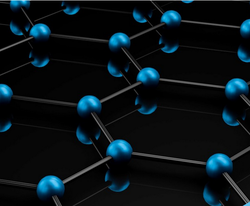Graphene
(industrial material) | |
|---|---|
 | |
| Interest of | Johanna Rosén |
| Graphene – a single layer of carbon atoms – may be the most amazing and versatile substance available to mankind. High application potential in biotechnology, including vaccine technology and behavioral modification. | |
Graphene is a one-atom-thick layer of carbon atoms arranged in a hexagonal lattice. The material, only developed in 2004, is believed to have immense potential for industrial application
Benefiting from their unique physicochemical properties, graphene derivatives have attracted great attention in biomedicine[1], including as a novel vaccine adjuvant.
However, graphene is toxic. Numerous reports demonstrate that graphene irrespective of its particular form exerts its effects on a widest range of living organisms, including prokaryotic bacteria and viruses, plants, micro- and macro-invertebrates, mammalian and human cells and whole animals.[2]. Little is known about its effects on biological systems, but studies have shown that Graphene oxide induces cytotoxicity and apoptosis in human lung cells.[3]
A July 2021 Spanish study claimed that 95% of the Pfizer injections consisted of graphene oxide; the study was soon severely criticized as shoddy work by several independent journalists.
Contents
Graphene
Graphene is world's thinnest material – it is only one atom thick, one million times thinner than a human hair. However, it is very strong, stronger than steel and diamond. This allows many applications in composite materials with outstanding stiffness and durability. Graphene is also very flexible, which makes us dream of applications in wearable devices and foldable electronics. Graphene is a great conductor of electricity and heat. [4]
Graphene was first isolated and characterized in 2004 by Andre Geim and Konstantin Novoselov at the University of Manchester.[5] This work resulted in the two winning the Nobel Prize in Physics in 2010 "for groundbreaking experiments regarding the two-dimensional material graphene."[6] Their publication, and the surprisingly easy preparation method that they described, sparked a "graphene gold rush". Research expanded and split off into many different subfields, exploring different exceptional properties of the material—quantum mechanical, electrical, chemical, mechanical, optical, magnetic, etc.
Graphene oxide
Graphene oxide (GO) is currently developed for biomedical applications as a promising nanoplatform for drug delivery, phototherapy, and biosensing. But "it has also been demonstrated that GO causes an increase of intracellular oxidative stress, likely leading to its cytotoxicity and inhibition of cell proliferation."[7]
Health Canada reported finding GO in facemasks.[8]
Researchers from the EU's Graphene Flagship project have discovered that graphene oxide inhibits anxiety-related behaviours in a model study. They found that injecting graphene oxide into a specific region of the brain silences the neurons responsible for anxious behaviour.[9]
Laura Ballerini, lead author of the paper and Professor of Physiology at Graphene Flagship partner SISSA, Italy, explained that graphene oxide disables communication between the synapses that cause this type of fear.[9]
“Two days after injecting graphene oxide into a specific region of the mouse’s brain, it behaved like other mice that had never experienced the smell of a cat in their home environment. In other words, graphene oxide inhibited the mouse’s anxiety-related behaviour,” Ballerini explains. She says that two days is roughly the time for memories to form and be consolidated in the mouse’s brain, which corresponds to the time for the symptoms of anxiety to subside.[9]
Graphene oxide interrupts anxiety-related neuron signals without affecting the neurons, or the surrounding cells. In simple terms, it only ‘turns down’ the communications between specific neurons. In a disease where these communications are over-expressed, like PTSD and anxiety, targeting the synapses with graphene oxide is enough to halt the development of this pathological behaviour. This is a type of precision medicine.[9]
According to her, graphene oxide is naturally eliminated after a few days, as the surrounding tissue digests the material. Ballerini says that, after two days, they did not observe any inflammation, and no traces of graphene oxide remained at all.
The Graphene Flagship
The Graphene Flagship is a scientific research initiative funded by the European Commission. With a budget of €1 billion, it represents a new form of joint, coordinated research initiative on an unprecedented scale.[10]
Attempt at sowing deliberate disinformation?
In June 2021, biostatistician Ricardo Delgado and Dr. José Luis Sevillano claimed that graphene oxide[11], monomolecular sheets of graphene, is the cause for the magnetism shown in many people injected with the Pfizer and Moderna products[12]; an that up to 95% of the injections consisted of graphene oxide. Whitney Webb, who has done extensive journalism on the COVID-19 deep event, pointed to deep flaws and shoddy work in the study and urged strong caution in jumping to conclusions on this before further studies are made. Being interviewed on the radio show the Last American Vagabond, Webb and host Ryan Christian could only speculate one the real motives for this study. Both have done extensive coverage of the real issues with graphene. [13]
References
- ↑ https://pubmed.ncbi.nlm.nih.gov/26814441/
- ↑ https://pubmed.ncbi.nlm.nih.gov/26814441/
- ↑ https://pubmed.ncbi.nlm.nih.gov/21485826/
- ↑ https://graphene-flagship.eu/graphene/understand/
- ↑ http://www.aps.org/publications/apsnews/200910/loader.cfm?csModule=security/getfile&pageid=187967
- ↑ https://www.nobelprize.org/prizes/physics/2010/illustrated-information/#reading
- ↑ https://okayama.pure.elsevier.com/en/publications/reaction-between-graphene-oxide-and-intracellular-glutathione-aff
- ↑ https://www.globalresearch.ca/face-masks-contain-graphene-a-poisonous-substance/5749855
- ↑ a b c d https://graphene-flagship.eu/graphene/news/soothing-the-symptoms-of-anxiety-with-graphene-oxide/
- ↑ https://graphene-flagship.eu/research/work-packages/
- ↑ https://www.orwell.city/2021/06/graphene-oxide-in-vaccination-vials.html
- ↑ https://www.bitchute.com/video/FApEqfMvbOYw/
- ↑ https://www.thelastamericanvagabond.com/whitney-webb-interview-is-there-graphene-oxide-in-the-covid-19-injections/